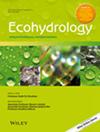摘要
为了支持这些河段鱼类资源的保护,本研究建立了基于主要鱼类生态需求的产卵场物理栖息地评价模型。采用人工神经网络(ANN)模型拟合产卵场指标与环境因子的响应关系。结果表明水温是影响产卵场的关键因素。在天然河道中,适宜产卵的时间主要在下午。而大坝下游的水温受水电运行的影响较大,导致产卵节律与自然河段有明显差异。产卵场加权可用面积(WUA)和斑块数(PN)随流量的增加先增大后减小。人工神经网络模型有效拟合了环境因子与WUA和PN的响应关系(R2 > 0.87)。水温的影响更大,而流量主要通过改变合适的底物面积来影响WUA和PN。研究结果揭示了产卵地的分布模式,并确定了关键的环境因素。研究结果为鱼类资源评价和保护提供了方法参考和科学依据,为高原河流本地鱼类种群的可持续管理提供了依据。

Hydropower development significantly impacts the fragile fish habitats in river reaches of the Tibetan Plateau. To support the conservation of fish resources in these reaches, this study developed a physical habitat evaluation model for spawning grounds based on the ecological requirements of key fish species. An artificial neural network (ANN) model was employed to fit the response relationships between spawning ground indicators and environmental factors. Results indicate that water temperature is a critical factor influencing spawning grounds. In natural river reaches, suitable spawning periods occur primarily in the afternoon. In contrast, water temperature in dam-downstream reaches is significantly affected by hydropower operations, leading to distinct differences in spawning rhythms compared to natural reaches. The Weighted Usable Area (WUA) and Patch Number (PN) of spawning grounds initially increase and then decrease with rising flow. The ANN model effectively fits the response relationships between environmental factors and WUA and PN (R2 > 0.87). Water temperature exhibits a stronger influence, while flow primarily affects WUA and PN by altering suitable substrate area. This study presents the development and application of physical and ANN models for fish spawning grounds in hydropower-affected river reaches of the Tibetan Plateau. The findings reveal the distribution patterns of spawning grounds and identify key environmental factors. These results provide methodological references and scientific evidence for the evaluation and conservation of fish resources, supporting the sustainable management of native fish populations in plateau rivers.

 求助内容:
求助内容: 应助结果提醒方式:
应助结果提醒方式:


